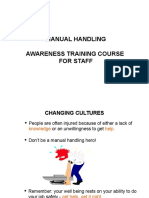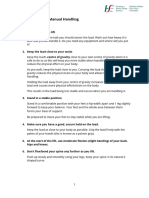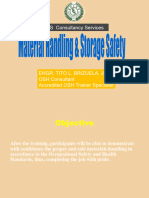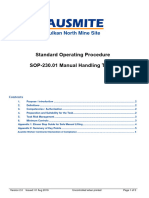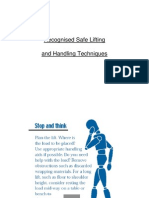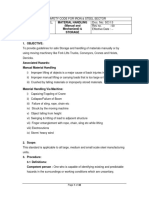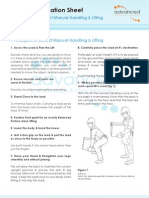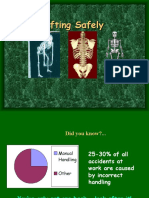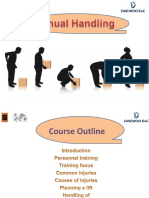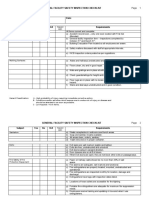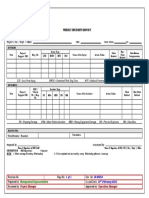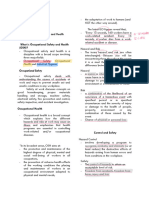2020 Empower People
Inspire Innovation
Development Date: October 2018 Revision Date: Sep 2020 Approved by: Mohmed Maitieg - QHSE Manager
� Introduction
What is Manual Handling?
It is the transporting or supporting of loads by hand or bodily force. This includes lifting up,
putting down, pushing, pulling, carrying and moving loads
These operations often result in injury caused mainly by:
➢ The unwillingness of people to seek assistance when involved in Manual Handling.
➢ The lack of knowledge concerning correct lifting and carrying techniques.
2
�Anatomic parts injured because of handling operations
3
�Avoidance of Manual Handling
➢ Mechanical Handling Aids.
➢ Risk assessment.
4
�Manual handling techniques
Prevent fatigue, prevent injuries
5
�Manual handling techniques
➢ Examine the load
➢ Feet placement and side stepping
➢ Keep the back straight
➢ Keep the load close to the body
➢ Use the leg muscles
➢ Use a “Palm” grip
➢ Team lifting
Small change in body position can make a big difference in power,
balance and stability for more control
6
�Maximum Weight Limit at Work
The maximum weight limit should be adjusted
depending on how the load is being lifted, how
close to the body the weight is held, and how
high or how low the weight is lifted.
7
�Feet placement and side stepping
Feet placement Place your feet apart for added stability.
Use side stepping technique then climbing the stairs
8
�Keep the back straight
Keep back straight, bend knees and get a firm grip on the load.
9
�Keep the load close to the body
Holding the load correctly: Keep the load close to the waist with
heavy side closest to body
10
�Use the leg muscles
11
�Use a “Palm” grip
12
�Team lifting
Is the load too much for one person?: Two people should carry
exceptionally large or heavy loads.
13
�Examine the load
Examine the load: Examine the weight, size and contents of the load
14
�Avoid overreaching
15
�Carrying long distances
16
�Excessive loads
Don’t lift an excessively heavy load
➢ Determine the weight
➢ Too heavy?
➢ Get help or use mechanical devices
17
�Don’t lift a load that is too large to handle
Determine the size
➢ Too big?
➢ Get help or use mechanical devices!
18
�Lift a load only if you can get a firm grip
Assess shape and grips
➢ Can’t hold it?
➢ Get help or use mechanical devices!
19
�Assess the location Where are you going
➢Can you get there safely?
➢Anything else going on?
➢Risks of falling?
➢Risks of slipping?
20
�Avoid twisting while lifting
21
�Check around you!
➢Any obstacles on the floor?
➢Or on the ceiling?
➢Or swinging around?
22
�Make sure you can see what you’re doing!
➢Bad lighting?
➢Heavy shadow?
➢Anything else blocking your view?
23
� EMPOWER PEOPLE
INSPIRE INNOVATION
THANK YOU!





